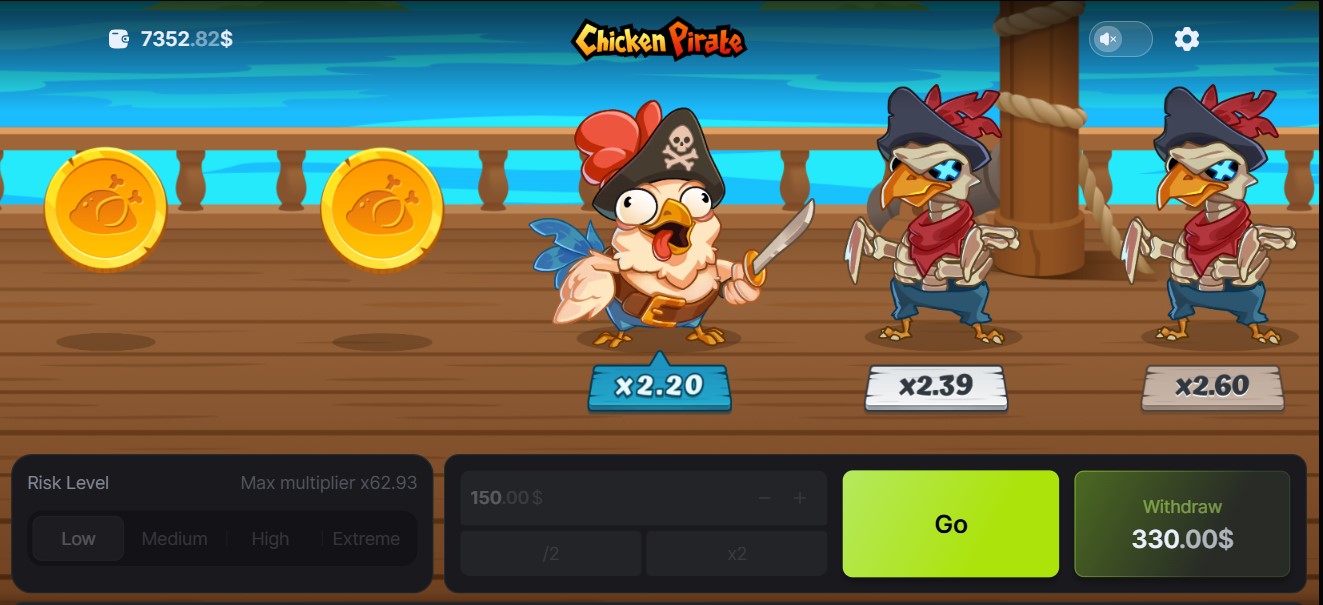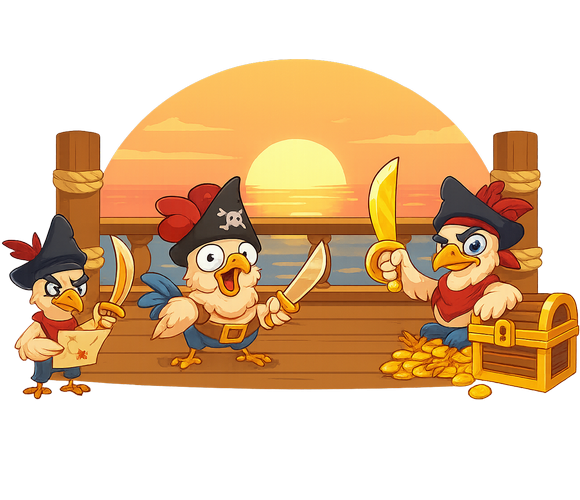My Journey With the Chicken Pirate Crash Game: A Player’s Review & Survival Manual
I’ve played plenty of online slots and crash games over the years, but nothing quite prepared me for the strange mix of chaos and charm that is the Chicken Pirate Crash Game. It’s one of those titles that sounds like a joke when you first hear it — a pirate chicken running across a booby-trapped board, carrying your bet in its feathery claws. But like many gambling games that sound ridiculous, it hides a surprisingly addictive mechanic and more tension than a horror movie jump scare.
This is my honest, detailed look at the game: not just how it works, but how it feels to play, what I’ve learned the hard way, and the strategies I actually use. I’ll walk you through the basics, the hidden traps (literally and metaphorically), and how to keep your bankroll alive long enough to enjoy the madness.

First Impressions: Meeting the Pirate Chicken
When I first loaded up the demo, I laughed. The graphics are cartoonish, the chicken struts like it owns the deck of a pirate ship, and then — bam — a trap door opens under its feet and it disappears. Bet lost. I hadn’t even clicked “cash out” yet.
That’s the entire premise boiled down:
You place a bet.
- The chicken takes steps forward, and with each step the multiplier climbs higher.
- At any moment, you can cash out and secure your winnings.
- Wait too long, and the chicken falls through a trap — you lose everything.
It’s simple in theory. In practice, it’s nerve-wracking. Every second you hesitate, you’re gambling between greed and caution. Do you grab a safe 1.5× payout, or push for that juicy 10× knowing a pit could open at any step?
The pirate theme adds humor, but don’t be fooled: this game is a psychological battlefield.
Learning the Mechanics the Hard Way
I started on demo mode (thankfully), because if I had jumped straight into real money, my bankroll would’ve sunk faster than a cannonball-hit ship.
Here’s what I figured out after a couple hundred rounds:
- RTP (Return to Player) is high — but volatility is brutal.
Some versions list RTP around 95–98%. That sounds generous compared to many slots. But don’t be fooled: you can easily hit 10 losses in a row, followed by one massive win that barely evens things out. - Difficulty levels matter.
The game often gives you options: Easy, Medium, Hard, Hardcore. On Easy, the chicken usually survives longer, so you can ride smaller multipliers safely. On Hardcore, it feels like walking through a minefield blindfolded — but the multipliers skyrocket. - Timing is everything.
The cash out button becomes your best friend and worst enemy. Click too early, and you feel like you “left money on the table.” Wait too long, and you get punished instantly. There’s no rewind.
I’ll be honest: the first time I watched my chicken fall through a trap just one step before my target multiplier, I slammed my desk. Then I laughed, because I realized that was the whole point. The game feeds on your greed.
How I Play: Strategies That Actually Work
Now, let’s get practical. I’ve tested different approaches, some smart, some stupid. Here’s what I found most useful:
1. The “Low Risk, Slow Grind” Method
- I set a small bet, like 1% of my total bankroll.
- I use auto cash out at 1.5× or 2×.
- Most rounds, I walk away with tiny profits.
It feels boring, but when I tracked results over 100 rounds, this method kept me afloat. It won’t make you rich, but it’s sustainable — and in crash games, survival is half the battle.
2. The “Hybrid” Approach
This is my favorite.
- I split my bankroll into two “buckets.”
- 70% goes into the safe grind strategy (small bets, early cash outs).
- 30% I reserve for “YOLO” runs where I aim for 5×–10× multipliers.
This scratches the thrill itch without draining my balance. Sometimes the big bet fails, but even then, my safe bucket cushions the loss.
3. The “Don’t Be Dumb” Rule
- No chasing losses.
- No doubling down (Martingale) endlessly.
- If I hit my loss limit (say, -20% of bankroll), I walk away.
Sounds obvious, but when that chicken falls through a trap five times in a row, your brain screams “just one more.” That’s when discipline saves you.
Bankroll Stories: Wins and Wipeouts
Let me give you real examples.
The Win:
I once put $5 on Hardcore mode with the intent of cashing out at 5×. The chicken just kept walking. 2×… 3×… 4×… my heart pounding, I clicked “cash out” at 7.2×. That’s $36 on a single run. For a moment, I felt like a genius.
The Wipeout:
Two nights later, I ignored my own rules. I kept raising bets after every loss, thinking “the next one HAS to hit.” Classic gambler’s fallacy. Within 15 minutes, my $50 balance was gone. Not even an epic crash multiplier saved me.
The lesson? The chicken doesn’t owe you anything. Every step is random. Treat it like entertainment, not a money machine.

Comparing It to Other Crash Games
I’ve played Aviator, JetX, and a few crypto crash clones. Chicken Pirate Crash stands out because:
- The theme is playful. Watching a pirate chicken stumble into traps is oddly fun.
- Difficulty levels add variety. Aviator doesn’t really give you that choice.
- The tension curve feels sharper. Steps are discrete, not a continuous line, so each “clunk” forward feels like a mini heart attack.
That said, it’s just as dangerous as other crash games. The house always wins in the long run — but the ride here is way more entertaining.
Emotional Side of the Game
What makes Chicken Pirate Crash so addictive isn’t just the potential profit. It’s the psychology:
- Anticipation. Every step, you wonder “Will the trap open now?”
- Greed. The multiplier climbs, your finger hovers over the button.
- Regret. Cash out early, you feel like a coward. Wait too long, you feel like an idiot.
The game weaponizes these emotions. Recognizing that helped me control myself. I started framing wins as “smart exits” rather than “missed chances.” That mindset shift saved me a lot of stress.
My Personal Rules for Staying Sane
After countless sessions, I built my own code of conduct. If you plan to try Chicken Pirate Crash, maybe this helps you too:
- Always start in demo. At least 50 rounds before touching real money.
- Set bankroll rules. 1% bets, 20% loss limit, 20% profit goal.
- Respect your emotions. If you’re angry or greedy, log off.
- Mix safe and risky play. Keeps it fun without bleeding money.
- Never trust patterns. Just because the chicken survived 10 steps last round doesn’t mean anything this time.
A Session That Changed My Mind
One evening, I sat with $100 in my account and promised myself I’d stop at either $120 or $80.
The first 20 minutes were brutal. Early traps, tiny wins, my balance dipped to $83. Old me would’ve tilted and gone all-in. Instead, I stuck with the grind: 1% bets, auto cash out at 1.8×.
Slowly, I crawled back. After an hour, I was at $118. Then a Hardcore run pushed me to $123. I cashed out, closed the tab, and went to bed smiling.
It wasn’t about the $23 profit. It was about finally proving to myself that discipline beats impulse. That’s the session I recommend everyone aim for: not the “I got rich overnight” fantasy, but the controlled, satisfying win where you beat yourself, not the game.

Final Thoughts
The Chicken Pirate Crash Game is hilarious, frustrating, and dangerously fun. It’s not for everyone — if you hate risk, stay away. But if you enjoy tension, quick rounds, and testing your willpower, it’s worth trying.
- My advice is simple:
- Play the demo first.
- Treat real money like a ticket to entertainment, not an investment.
- Use strategies, but accept that luck rules.
- And most importantly, know when to walk away.
Because here’s the truth: the pirate chicken will fall eventually. The only question is whether you cashed out in time — or whether you let greed send you down with it.














